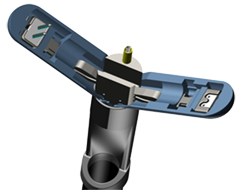
Market
Upper GI Endo-Surgery
Client Type
VC-funded startup (NDO Surgical)
Unmet Need
Minimally-invasive treatment for reflux disease that is less traumatic than current surgical practice (Nissen fundoplication) and more effective than drugs, including proton pump inhibitors like Prilosec.
Approach
Develop a trans-esophageal instrument capable of forming a full-thickness plication (fold) in the stomach wall just below the gastro-esophageal junction (GEJ). The instrument deploys a soft implant to maintain the plication. This plication tightens the GEJ and prevents reflux of stomach acids into the esophagus.
 Product Features
Product Features
50fr shaft conducts gastroscope into stomach. Controls on ergonomic handle provide control of distal articulation, jaw opening/closing, extension/retraction of tissue screw, and deployment of implant. Implant comprised of two soft pledgets (pads) connected by sutures. Procedure done under topical anesthesia in a doctor’s office in as little as 10 minutes. FDA approved and on the market.
Services Provided by OTI
- Mechanical engineering, including design of unique articulating vertebrae, transmission mechanism, control cabling, molded silicon part design, injection molded part design & vendor sourcing
- Development of assembly methods, including bonding, overmolding and fastening
- FDA-compliant drawings
- Prototyping
- Verification & validation testing
- Transfer to manufacturing